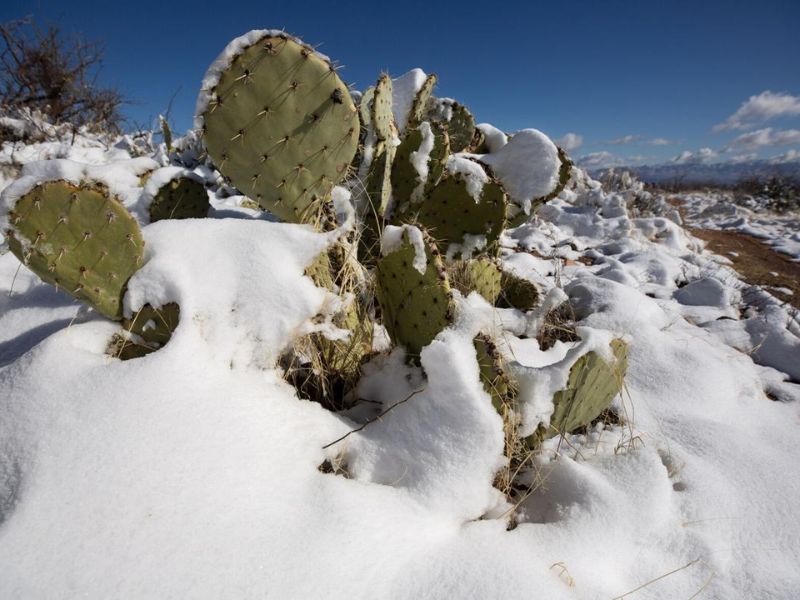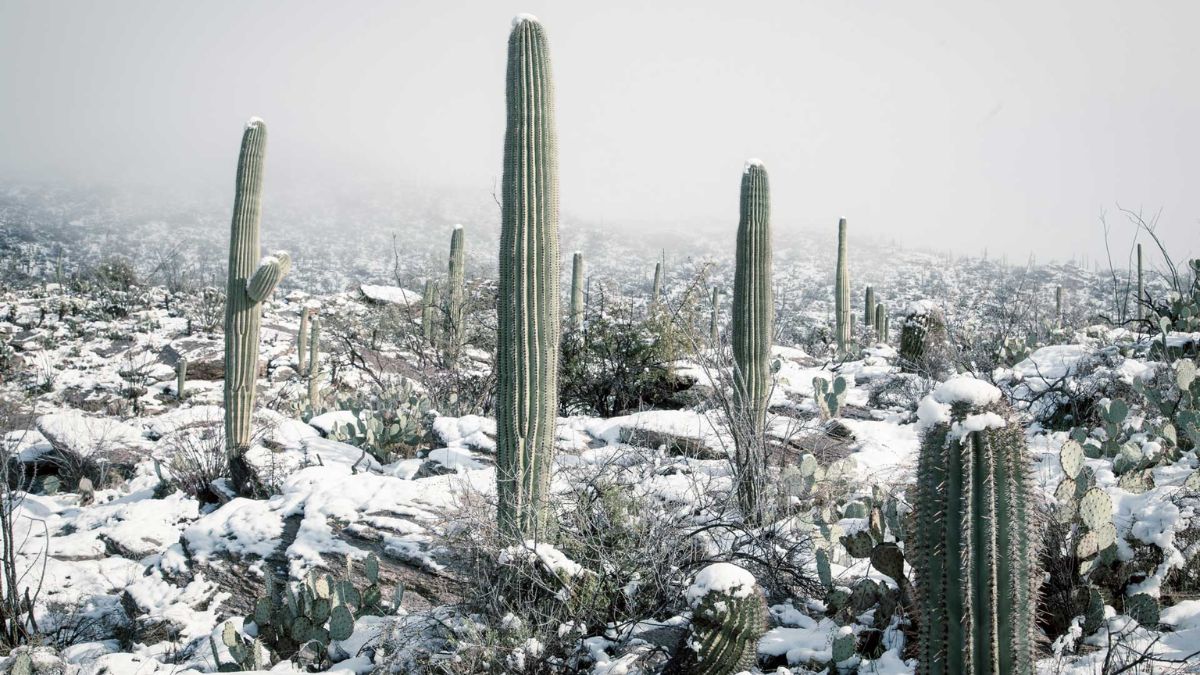Yes, it does snow in Tucson, Arizona, although snowfall in the city is relatively rare. Tucson, located in the Sonoran Desert, typically experiences a desert climate with hot summers and mild winters. However, due to its higher elevations and proximity to mountain ranges, snow can occasionally occur during the winter months.
When snow does fall in Tucson, it can have an impact on daily life, as the city’s infrastructure and residents are not accustomed to dealing with heavy snowfall. However, many locals embrace the rare occurrence, enjoying the opportunity to engage in winter activities and build snowmen.
For those seeking a snowy escape in Tucson, the nearby Mount Lemmon offers a picturesque winter retreat. The higher elevations of the mountain receive more snowfall, providing opportunities for skiing, snowboarding, and enjoying the scenic beauty of a snow-covered landscape.
When people think of Tucson, Arizona, they often picture a desert landscape with scorching summers and mild winters. However, the question arises: Does it snow in Tucson, AZ?

In this article, we will delve into the climatic conditions of Tucson, AZ, and explore the occurrence and impact of snowfall in this southwestern city.
Location Overview
Tucson, Arizona, is a vibrant city nestled in the heart of the Sonoran Desert in the southwestern United States. Known for its unique blend of natural beauty, rich cultural heritage, and outdoor adventures, Tucson offers a captivating experience for residents and visitors alike.
Geographically, Tucson is situated in Pima County, approximately 120 miles southeast of Phoenix, the capital of Arizona. It is surrounded by several mountain ranges, including the Santa Catalina Mountains to the north, the Rincon Mountains to the east, and the Tucson Mountains to the west.
The city’s proximity to numerous mountain ranges offers opportunities for hiking, rock climbing, and exploring scenic trails. Mount Lemmon, located in the Santa Catalina Mountains, provides a refreshing escape with cooler temperatures and pine forests—a true contrast to the desert environment.
The arts scene in Tucson is thriving, with numerous galleries, museums, and performance venues. The Tucson Museum of Art and Historic Block showcases a wide range of art, including contemporary works and pieces from the region’s Native American and Hispanic communities.
Overall, Tucson captivates visitors with its stunning desert landscapes, mild winters, rich cultural heritage, and thriving arts scene. Whether exploring the outdoors or immersing yourself in the city’s history and traditions, Tucson offers a unique and unforgettable destination for those seeking an authentic southwestern experience.
Geography and Climate of Tucson
The geographical factors that influence snowfall in Tucson, Arizona, include its higher elevations and proximity to mountain ranges. These factors contribute to the occasional occurrence of snow during the winter months, adding a touch of novelty to the desert region.
Tucson boasts a desert climate characterized by hot summers and mild winters. The city enjoys abundant sunshine throughout the year, with more than 300 sunny days annually.
Summers are long and dry, with average high temperatures surpassing 100 Fahrenheit during June, July, and August. Winters are generally mild, with average high temperatures ranging from the mid-60s Fahrenheit to the low 70s Fahrenheit.
However, winter brings milder conditions, making it an appealing escape for those seeking refuge from colder climates. While snow might not be the first thing that comes to mind when thinking of Tucson, surprises can happen.
Historical Snowfall Record
On average, Tucson receives around 1 inch of snow per year. However, it is important to note that these measurements vary significantly from year to year. Some years may see no snowfall at all, while others may experience heavier accumulations.
Tucson, Arizona, has a relatively limited historical snowfall record due to its arid desert climate. However, notable snow events have been recorded over the years. The last significant snowfall in Tucson occurred in February 2019, when the city received approximately 3 inches of snow.
Prior to that, December 2013 saw a significant snowfall event, with the city receiving around 6.5 inches of snow. Although infrequent, these events showcase the unique snowfall phenomenon in Tucson.
Winter Season & Snowfall Pattern
While snowfall in Tucson is rare, it is not entirely unheard of. The city’s higher elevations and proximity to the Santa Catalina Mountains create the conditions necessary for snow.
Generally, the snowy weather occurs during winter, with December, January, and February being the most likely times to experience flurries. When snow does fall in Tucson, it tends to be a noteworthy event.
Despite the potential inconvenience, many locals embrace the rare occurrence, finding joy in building snowmen and engaging in winter activities.
Locations to Enjoy Snow
While Tucson, Arizona, is not typically associated with snowy landscapes, there are a few locations near the city where you can enjoy the beauty of snow during the winter months. Here are some popular spots:
- Mount Lemmon
Located just northeast of Tucson, Mount Lemmon offers a picturesque winter retreat. As you ascend the mountain, the landscape transforms into a winter wonderland with snow-covered pine trees and scenic views.
- Sabino Canyon
Although snowfall in Sabino Canyon is rare, the surrounding mountains often receive snow during winter. Hiking the trails in Sabino Canyon after a snowfall can offer stunning views of the snow-capped peaks and the unique juxtaposition of desert and winter scenery.
- Saguaro National Park
Saguaro National Park, located on Tucson’s east and west sides, is known for its iconic saguaro cacti and desert landscapes. Snow blankets the park’s surroundings, creating a remarkable contrast against the towering cacti, resulting in striking and memorable photo opportunities.
- Catalina State Park
Situated in the Santa Catalina Mountains, Catalina State Park offers scenic trails and breathtaking vistas. During winter, the higher elevations of the park may receive snow, making it an excellent destination for winter hiking or enjoying a snowy picnic amidst the stunning desert scenery.
- Tucson Mountain Park
Located west of Tucson, the Tucson Mountain Park features scenic desert landscapes and numerous trails. While snowfall is uncommon, the park can offer panoramic views of the snow-capped peaks in the distance after a winter storm.
Remember to check weather conditions and road closures before visiting these locations during winter, as snowfall can impact accessibility and safety. Additionally, it’s advisable to bring appropriate clothing and equipment to fully enjoy the snowy experience.
Factors Influencing Snowfall
Several factors influence snowfall in Tucson, Arizona. The city’s higher elevations, ranging from around 2,500 to 9,100 feet, play a significant role. As elevation increases, temperatures tend to drop, creating conditions more conducive to snow formation.
Additionally, Tucson’s proximity to mountain ranges, such as the Santa Catalina Mountains, allows for moisture-laden air to be forced upwards, leading to cooler temperatures and increased chances of snowfall.
However, Tucson’s overall arid desert climate means that snowfall remains relatively rare and sporadic compared to regions with more significant winter precipitation.
Conclusion
While snowfall in Tucson, AZ, is infrequent, it does occur from time to time, adding a touch of novelty to the desert region. Although snow might not define the typical winter experience in Tucson, the occasional flurries bring delight and excitement to both locals and visitors alike.
So, if you find yourself in Tucson during the winter months, keep an eye on the forecast—you might just get to witness the desert transforming into a winter wonderland.
